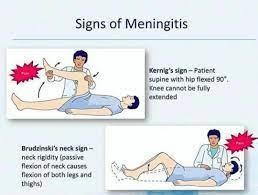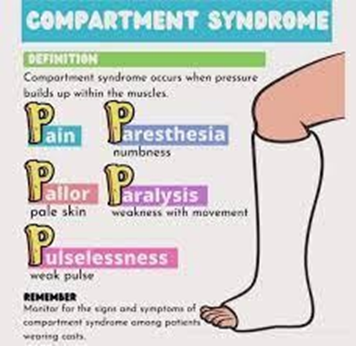A client is brought to the emergency department due to vomiting, fever, and a severe headache. The physician suspects meningitis; then assesses the client for meningeal irritation and spinal nerve root inflammation. The nurse documents a positive Kernig's sign when:
The client's forearm spasms when a blood pressure cuff is inflated on the upper arm.
The client complains of pain when his knee is extended with his hip flexed.
The client feels pain in the calf when his foot is dorsiflexed.
The client has a stiff neck when the neck is flexed towards the chest.
The Correct Answer is B
Choice A rationale: This is a positive Trousseau's sign, which indicates hypocalcemia or tetany. It is not related to meningitis or meningeal irritation.
Choice B rationale: Kernig's sign is indicated when there is resistance and pain with knee extension and hip flexion, suggesting meningeal irritation.
Choice C rationale: This is a positive Homan's sign, which indicates deep vein thrombosis or phlebitis. It is not related to meningitis or meningeal irritation.
Choice D rationale: This is a sign of nuchal rigidity, which indicates meningeal irritation, but it is not specific to Kernig's sign. Nuchal rigidity can also be caused by other conditions such as cervical arthritis or muscle spasm.

Nursing Test Bank
Naxlex Comprehensive Predictor Exams
Related Questions
Correct Answer is D
Explanation
Choice A rationale: An increase in serum lipid levels is associated with nephrotic syndrome, not recovery.
Choice B rationale: A decrease in blood pressure to normal might be beneficial but is not a definitive indicator of recovery from nephrotic syndrome.
Choice C rationale: Gain in body weight can occur due to fluid retention, which is a symptom of nephrotic syndrome, and doesn't indicate recovery.
Choice D rationale: The disappearance of protein from the urine is a sign of recovery in nephrotic syndrome.
Correct Answer is D
Explanation
Choice A rationale: Tachycardia and petechiae over the chest wall and buccal membranes are signs of fat embolism syndrome, another complication of fractures that occurs when fat globules enter the bloodstream and obstruct pulmonary vessels.
Choice B rationale: Positive Homan's sign with calf tenderness and warmth are signs of deep vein thrombosis, a condition that can occur after prolonged immobilization or surgery.
Choice C rationale: Acute cough, cyanosis, and decreased blood pressure are signs of pulmonary embolism, a life-threatening condition that occurs when a blood clot travels to the lungs and blocks blood flow.
Choice D rationale: These are signs of compartment syndrome, which is a serious complication of fractures that occurs when increased pressure within a closed space compromises blood flow and tissue perfusion. Compartment syndrome can lead to ischemia, necrosis, and nerve damage if not treated promptly.

Whether you are a student looking to ace your exams or a practicing nurse seeking to enhance your expertise , our nursing education contents will empower you with the confidence and competence to make a difference in the lives of patients and become a respected leader in the healthcare field.
Visit Naxlex, invest in your future and unlock endless possibilities with our unparalleled nursing education contents today
Report Wrong Answer on the Current Question
Do you disagree with the answer? If yes, what is your expected answer? Explain.
Kindly be descriptive with the issue you are facing.
